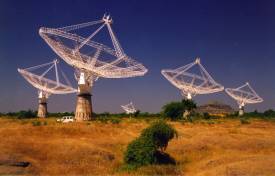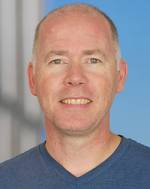Huib Intema
Dr. ing. Hubertus T. Intema
IT support scientist & radio astronomer at Leiden Observatory
Curriculum Vitae
Travel agenda
Project archive
Useful links
Overview
 I am a radio astronomer and IT support scientist working at (Leiden Observatory), the astronomical research institute of Leiden University in the Netherlands. My area of expertise is low-frequency radio interferometry, studying the Universe at radio frequencies below 1 GHz with telescopes like the Giant Metrewave Radio Telescope (GMRT) and the Very Large Array (VLA). These are technically challenging observations to process, complicated by the need to image and deconvolve hundreds of sources in a typical Field Of View (FOV) of many degrees in diameter, the abundant presence of man-made Radio-Frequency Interference (RFI), and the distorting effects of the Earth's ionosphere. Over the course of several years, I have build and refined a set of software tools to process these observations in an efficient and reproducible way, typically yielding high-quality images. These tools are now systematically applied in many different science projects involving low-frequency radio interferometric observations.
I am a radio astronomer and IT support scientist working at (Leiden Observatory), the astronomical research institute of Leiden University in the Netherlands. My area of expertise is low-frequency radio interferometry, studying the Universe at radio frequencies below 1 GHz with telescopes like the Giant Metrewave Radio Telescope (GMRT) and the Very Large Array (VLA). These are technically challenging observations to process, complicated by the need to image and deconvolve hundreds of sources in a typical Field Of View (FOV) of many degrees in diameter, the abundant presence of man-made Radio-Frequency Interference (RFI), and the distorting effects of the Earth's ionosphere. Over the course of several years, I have build and refined a set of software tools to process these observations in an efficient and reproducible way, typically yielding high-quality images. These tools are now systematically applied in many different science projects involving low-frequency radio interferometric observations.
 My primary astronomical interest is to understand the origin of large-scale diffuse radio emission regions in clusters of galaxies, namely radio halos, radio relics, and radio phoenices. Their emission extends over areas of tens to hundreds of kilo-parsecs – often a Mega-parsec or more – and appears to be unrelated to any individual galaxy in the cluster. Only a fraction of the known clusters harbors this kind of emission, but all of these show signs of recent merging activity. This strongly suggests that the energy required to generate these emission regions comes from the potential energy released in the merger, but the exact physical mechanisms are still debated. Understanding these mechanisms is part of the puzzle in understanding how the largest gravitationally bound structures in the Universe form and evolve.
My primary astronomical interest is to understand the origin of large-scale diffuse radio emission regions in clusters of galaxies, namely radio halos, radio relics, and radio phoenices. Their emission extends over areas of tens to hundreds of kilo-parsecs – often a Mega-parsec or more – and appears to be unrelated to any individual galaxy in the cluster. Only a fraction of the known clusters harbors this kind of emission, but all of these show signs of recent merging activity. This strongly suggests that the energy required to generate these emission regions comes from the potential energy released in the merger, but the exact physical mechanisms are still debated. Understanding these mechanisms is part of the puzzle in understanding how the largest gravitationally bound structures in the Universe form and evolve.
In my current role at Leiden Observatory I provide IT support for researchers and groups such as the ALMA Local Expertise Group (Allegro). I also continue some of my activities at Leiden Observatory, being part of the LOFAR Surveys Key Science Project (LSKSP), aimed at radio imaging the Northern hemisphere at unprecedented resolution and sensitivity using both the High-Band Antennas (HBA; 120-240 MHz) and Low-Band Antennas (LBA; 30-80 MHz).
Education and Experience
| 2020 – now | IT support scientist & radio astronomer, Leiden Observatory |
| 2019 | Senior research fellow, Curtin Institute of Radio Astronomy |
| 2015 – 2018 | LOFAR/SKA research scientist, Leiden Observatory |
| 2012 – 2015 | VLA research associate, NRAO Socorro |
| 2009 – 2012 | Jansky fellow, NRAO Charlottesville |
| 2005 – 2009 | PhD candidate in radio astronomy, Leiden Observatory |
| 2000 – 2004 | Combined BSc/MSc degree in astronomy, Leiden University |
| 1996 – 2000 | Technical software engineer, High Tech Automation |
| 1994 – 1996 | Engineering degree in electronics, Hogeschool Utrecht |
| 1993 | Military service, Royal Dutch Army |
| 1989 – 1992 | Partial BSc in electronics, Delft University |
Research interests
- Large-scale structure – merging galaxy clusters: Mpc-scale diffuse radio sources (halos, relics), tailed radio galaxies, ICM physics
- Radio sky surveys: low-frequency radio sky, large-area surveys, high-redshift radio galaxies
- Radio interferometry: wide-field calibration and imaging, automated data reduction, algorithm development, the ionosphere
Current projects
- TGSS ADR: GMRT 150 MHz all-sky survey Alternative Data Release (with Jagannathan, Mooley, Frail)
- SPAM: automated processing of GMRT observations (including direction-dependent calibration)
- C-SPAM: implementation of SPAM in CASA for processing wide-bandwidth uGMRT and JVLA-lowband observations (with de Gasperin)
- … and others
Publications and Profiles
Supervision
Current
- None
Previous
- Soumyajit Mandal: PhD candidate mainly working on LOFAR HBA observations of the Lockman hole (extremely deep survey), Abell 1914 (merging galaxy cluster) and other clusters containing radio phoenices.
- Joshua Albert: PhD candidate mainly working on LOFAR HBA observations of the GOODS-North field (survey), and on techniques to improve ionospheric calibration and radio spectral index mapping.
- Alexandar Mechev: PhD candidate mainly working on optimization of the processing pipeline for the LOFAR HBA survey, and porting to distributed computer platforms.
- Susie Tuntipong: MSc candidate working on wide-band radio imaging of NGC253 using uGMRT to identify HII regions (with Oonk and Tielens).
- Vivienne Kolman: MSc candidate working on a high-resolution radio survey of part of the Galactic plane to search for missing SNRs (with de Gasperin).
- Martijn Oei: MSc candidate working on wide-band calibration for uGMRT and studying the properties of radio galaxies as a function of environment in the GAMA fields (with de Gasperin).
- Dieuwertje van der Vlugt: MSc candidate working on JVLA L-band (1-2 GHz) intensity and polarization maps of double radio relic galaxy cluster PSZ1 G108.18-11.53 (with de Gasperin).
- Gabriella Di Gennaro: LEAPS summer student working on JVLA P-band (240-480 MHz) intensity maps of M87 / Virgo A (with de Gasperin).
- Kasper van Dam: MSc candidate working on implementing wide-bandwidth SPAM ionospheric calibration using CASA (with de Gasperin).
Teaching
- 2016-2017: Radio Astronomy MSc course (with Huib van Langevelde)
Nominated for Faculty of Science Teaching Award
Visitors (since May 24, 2017):






